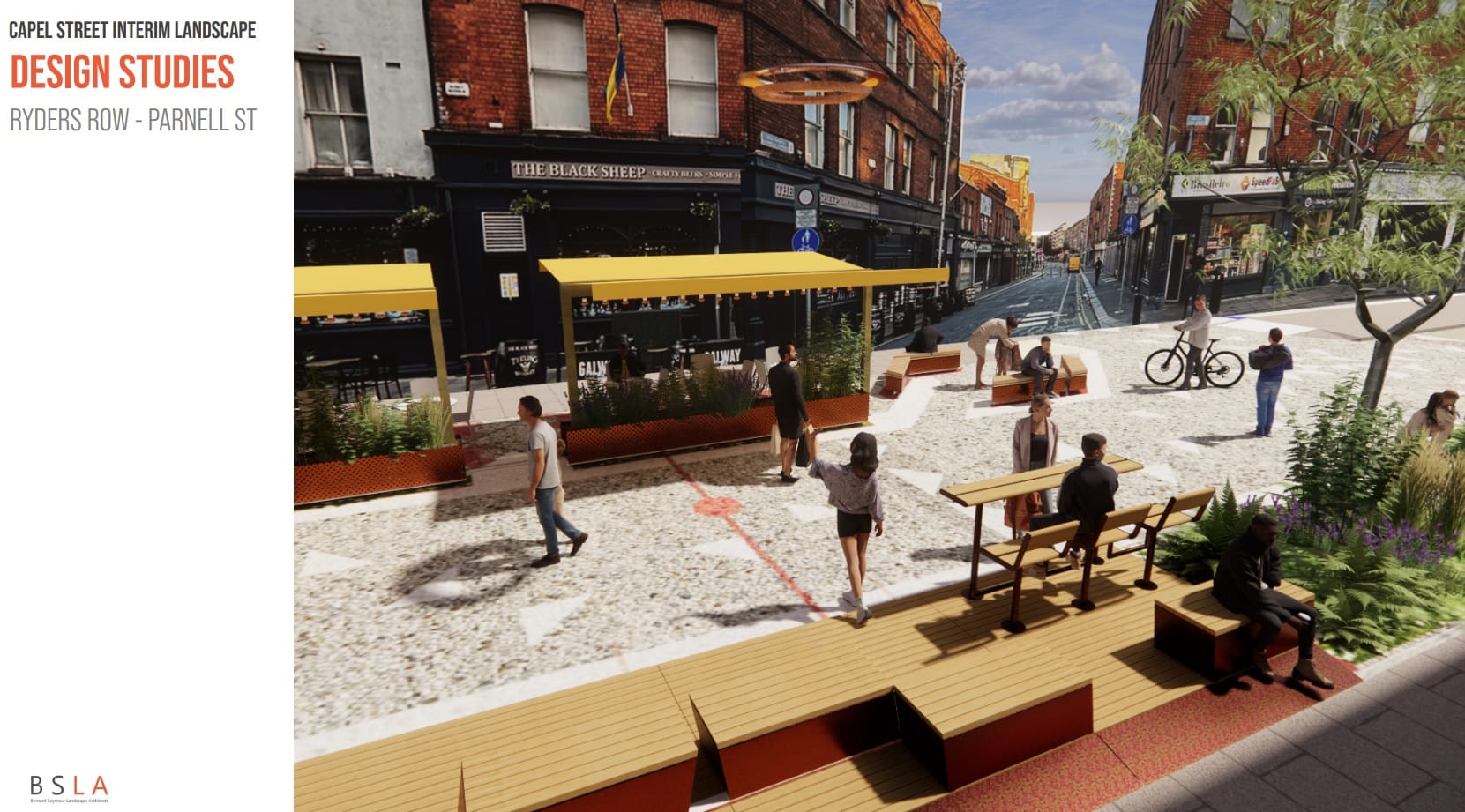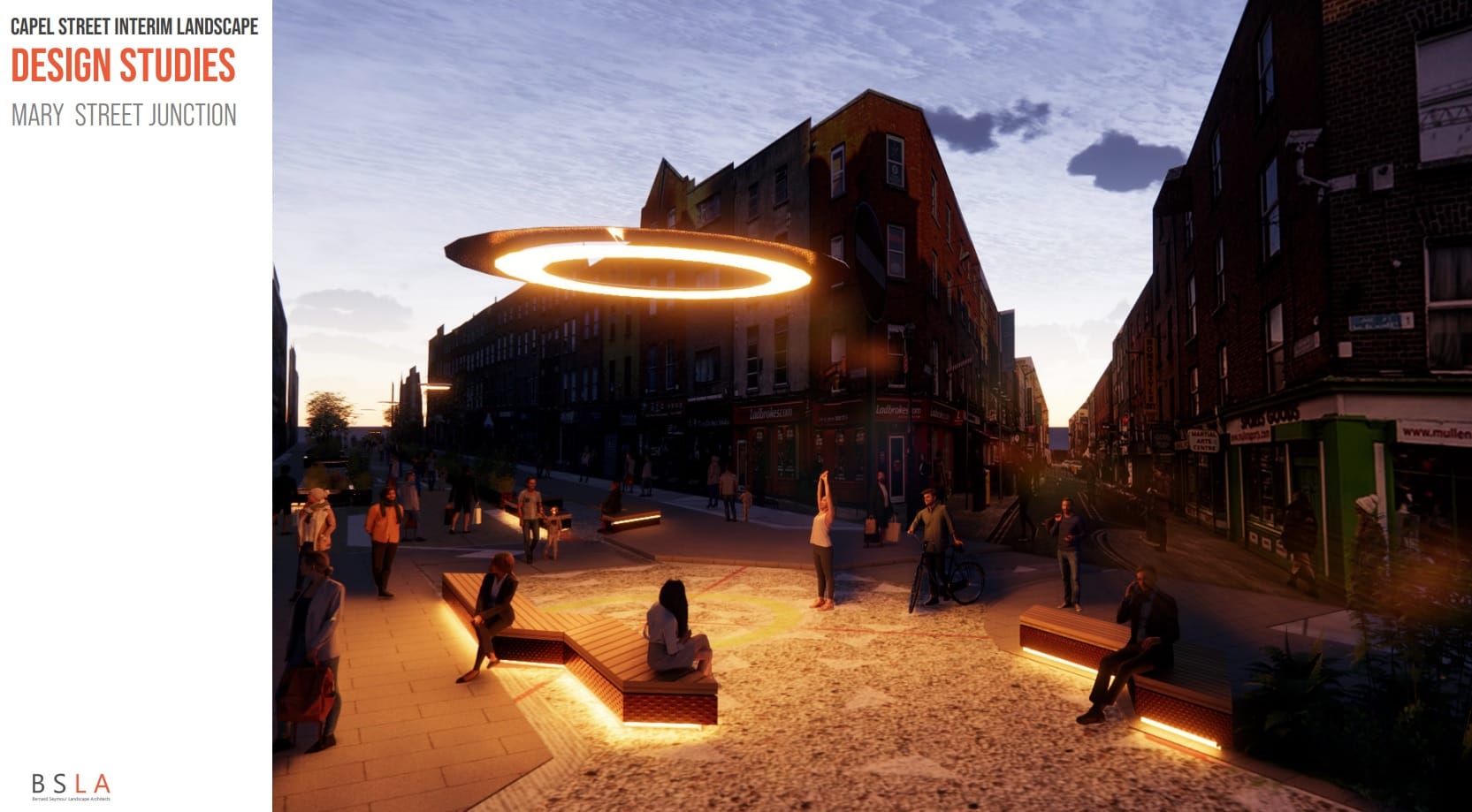What’s the best way to tell area residents about plans for a new asylum shelter nearby?
The government should tell communities directly about plans for new asylum shelters, some activists and politicians say.
“The spirit of Capel Street is really old Dublin,” says architect Bernard Seymour. “It’s an old trading street and it still has this individual vibe.”

Architect Bernard Seymour has an idea as he reaches the top of Capel Street.
He stops at a disused piece of road, about the size of a few car parking spaces, after bollards mark the end of Little Britain Street a bit of a way back.
“What we are doing is we are just checking that each little space that is not needed for a car or a delivery could be used for something else,” says Seymour.
“The west light,” he says pointing up Little Britain Street, which does seem a bit brighter. “That would be a nice place for children to play.”
He’s been looking for a spot to incorporate a children’s play feature into the new plans for Capel Street.
The new plans were commissioned by Dublin City Council, which decided to make Capel Street traffic-free last year after a trial during the Covid-19 restrictions.
Seymour, managing director of Bernard Seymour Landscape Architects, says that every architect in the company chipped in to create the vision for a new Capel Street.
They talked to local residents, workers and business owners on the street as they drew up the designs. A video shows wooden platforms with outdoor seating, planters and trees as well as decoration including some bold lighting features.
Capel Street is unusual for a city-centre shopping street because most of the businesses are independent, often run by the owners, says Seymour. The design should reflect the community feeling of this historic trading street.
“The spirit of Capel Street is really old Dublin,” says Seymour. “An old Dublin Street with old Dublin characters.”
Just off Capel Street at 4 Mary’s Abbey is Seymour’s architecture practice
In a top floor office, a paper map of Capel Street runs in a strip across the length of three tables.
Seymour points to the Ryder’s Row end of Capel Street to the north, and runs his hand down to where it intersects with Mary Street, about halfway along.
That is phase one of the redevelopment of the street, which he hopes could be complete this summer, he says.
The architects have met with local residents and gone door to door to talk to business people on the street, says Seymour. They met lots of very articulate people with well thought-out ideas for how to improve the street, he says.
“There is a tremendous reservoir of love for the city,” he says. “People are frustrated because they are not getting what they want.”
Some people who were not initially in favour of a car-free Capel Street have come around to the idea once they saw the potential, he says.
Seymour is excited about that potential. “It’s very distinctive. It’s an old trading street and it still has this individual vibe.”
“It does look lovely, it hasn’t been broken up into office blocks,” he says. Inside the buildings, he noticed that some still have period features, he says.
His colleague, senior landscape architect Colin Torpay, talks through the video showing the draft plans. He circles his hand over a wooden platform with a table and a bench on it.
“We can start to use lighting,” says Torpay, pointing out the lights at the base of a platform. “You might have someone who is sitting having a coffee and they’re talking to their friend,” he says, while the friend is standing on the street.
“And you are starting to make a community of the street,” says Seymour.
Seymour is talking to organisations for people with disabilities as well to try to ensure that the new design is accessible for everyone. “So that nobody feels they are removed from part of the street,” he says.
Removing kerbs from a car-free street obviously opens up the street – but some visually impaired people use the curb as a guide when using a cane, he says.
He will replace the kerbs with something that they can tap instead, he says.
He wants pedestrians to walk on the main road. At the moment most don’t, in part because of cyclists and scooters whizzing past, he says.
So, he will slow them down slightly by raising the level of the road at the junctions. “We support cyclists,” he says. “They can go at quite a pace but not that speed they are going at the moment.”
The plans include benches as well as raised platforms with tables and seating.
Seymour says that he wants to ensure that the public outdoor seating is comfortable so that people use it. They are “a bit more luxurious, contemporary and spacious”, he says.
“Nowadays if you come to Capel Street to shop or dine it’s a choice,” he says. “So you need to make the street more attractive in every way so people will linger a little bit longer.”
There are food and drink businesses on Capel Street that have licences for outdoor tables and chairs too, says Seymour.
So they are factoring the needs of those businesses into the overall design. If the businesses decide to get canopies they’ll be able to clip the canopy into an existing planter.
That avoids a higgledy-piggledy look later on, he says. “We are not doing the canopies as part of this but we are trying to build in a structure that would allow an easy canopy to be dropped into them.”

The planters and the outdoor seating are all pre-built units called parklets, which are around the width and length of a car parking space, says Torpay.
The advantage of that system is that if, for any reason, they need to move something or change the layout, it’s easy to come along with a forklift and lift it out, he says. “You can string them together, like modular furniture.”
They are currently looking to see what services are underground so that they can plant trees too, he says.
One eye-catching feature of the plans is a large lit-up disk suspended in the air that looks like a UFO.

“It’s an approach to one type of lighting that you could do here,” says Torpay, pointing to the intersection of Capel Street and Mary Street, which runs straight down from Henry Street.
On an average Saturday, there could be 80,000 to 100,000 people on Henry Street, he says, so the idea of lighting and other decorative features is to draw people’s attention to Capel Street.
“We are talking about these raised tables and lighting and features as beacons, they would be a visual attractor,” he says.
All the plans are currently a draft, says Seymour, so they continue to seek feedback from locals and the wider community.
Get our latest headlines in one of them, and recommendations for things to do in Dublin in the other.